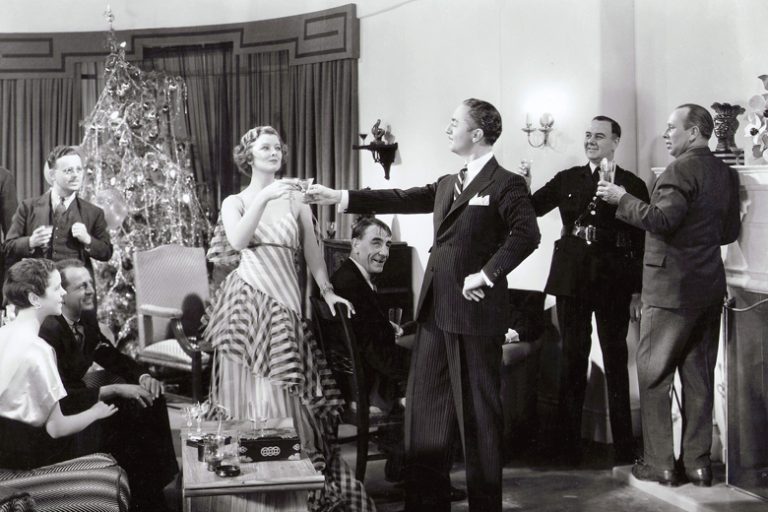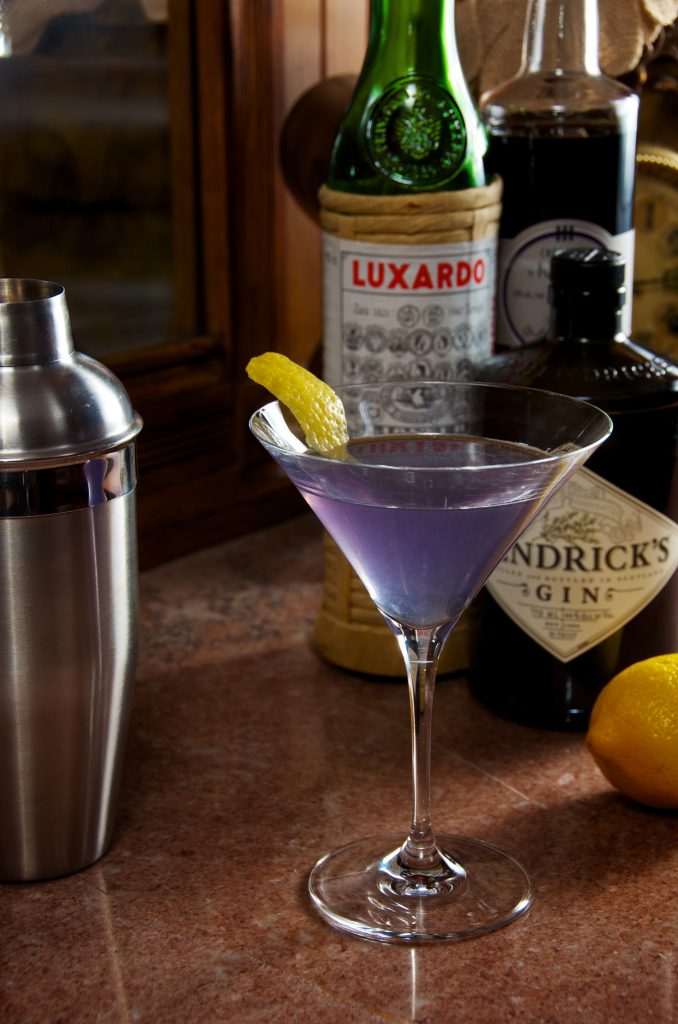Christmas With Nick and Nora
"Highballs and cocktails - the long and short of it." — William Powell as Nick Charles in The Thin Man, delivering the filthiest line of 1934.
On December 5, 1933, the United States ended Prohibition. A scant six months later, in May of 1934, MGM released The Thin Man, the first in a series of comedic mystery films based on a novel by Dashiell Hammett (who also wrote an obscure little novel called The Maltese Falcon) and starring William Powell and Myrna Loy as a couple of high-living socialites who, in their spare time, solve the occasional murder. It's an exceedingly funny movie, not to mention romantic, sassy and charming. It is also perhaps the drinkingest drinking movie ever made, a fittingly celebratory kick to the corpse of Prohibition.
Nora is the sophisticated one, swathed in an array of elegant 1930s finery and exquisitely played by Myrna Loy. William Powell's Nick Charles, her husband, is a little rougher around the edges, a former detective who has retired and is happy to live the high life, though he can't seem to keep from getting embroiled in cases and being visited by the gruff assortment of ex-cons who, despite having been put behind bars (editor's note: the judicial kind) by Nick, admire him and want to hang out. Nora, for all her rich upbringing, delights in these intrusions from her husband's seedy past. It adds just the right touch of danger to their lives.
Although it was a summer release, The Thin Man is set during Christmas and, albeit a Christmas with murder, mayhem and a cast of supporting characters who say "buster" and "fella" a lot. It's also a defiance of — or at least, an escape from — the Great Depression, allowing audiences to slip, for a little while, into a world free from dust bowls and poverty and instead awash in gorgeous gowns, witty banter and lots of booze. So in the spirit of the season, I thought we should all come together like Nick and Nora on Christmas Eve and raise a glass to holiday spirits and the end of 2016.
Nick and Nora Martini, Manhattan, and Bronx
When first we meet Nick Charles, he is discussing with a waiter and bartender the proper musical tempo at which to shake an assortment of cocktails. The three he names are the Manhattan, the Bronx, and of course the Martini (yes, he shakes his martinis—decades before James Bond and the shaken or stirred controversy.) We discussed the Nick and Nora Martini, the Bronx, and the related Brooklyn cocktails in Martini & Myth Part 3: Shaken, Not Stirred, so I'll refer you to that article for the recipes. The Manhattan is so well known now that we hardly need mention it here, though we'll certainly have one if you're shaking it to a foxtrot. But what about the other New York boroughs? There was, in fact, a Queens cocktail, created by celebrity bartender Harry Craddock. It's basically just the Bronx with pineapple instead of orange.
Queens Cocktail
Half a Slice of Crushed Pineapple
.75 oz/22 ml Sweet Vermouth
.75 oz/22 ml Dry Vermouth
1.5 oz/44 ml Gin
Muddle pineapple in shaker. Add all ingredients and ice then shake well (no word on which rhythm to shake to). Strain into cocktail glass.
French 75
A classic of the era, the French 75 is named for the famed artillery cannons of the French army. It's also a popular cocktail in movies, making its most famous appearance in Casablanca.
.5 oz/15 ml Lemon juice
.5 oz/15 ml Simple syrup
1 oz/30 ml Gin (some classic recipes use Cognac instead of gin)
3 oz/88 ml Champagne
Add all the ingredients except the Champagne to a shaker and fill with ice. Shake well and strain into a Champagne flute. Top with Champagne and garnish with a lemon twist.
Mary Pickford
Mary Pickford was one of the most beloved stars of the silent era, a Canadian who became "America's Sweetheart" and starred in many of the highest grossing movies of the 1910s. She was also a pioneering filmmaker, one of the first women to step behind the camera and the production desk. Along with Charlie Chaplain, director D.W. Griffith and swashbuckling actor (and Mary's eventual husband) Douglas Fairbanks, she founded United Artists, a studio dedicated to giving more power and creative freedom to writers, directors and stars. The cocktail created in her honor, according to Cuban Cocktails by Jared Brown and Anistatia Miller, was concocted in the 1920s by barman Fred Kaufman, at the Hotel Nacional de Cuba. It is a place she was known to visit while on vacation with Chaplin and Fairbanks.
1.5 oz/44 ml White rum (use Havana Club real Cuban rum if you can find it. If not, a good Caribbean white rum such as Banks 5 Island.)
1.5 oz/44 ml Pineapple Juice
1 tsp Grenadine
6 drops Maraschino liqueur (such as Luxardo)
Add all the ingredients to a cocktail shaker and fill with ice. Shake, and strain into a chilled cocktail glass.
Aviation
This striking violet-colored cocktail, created by Hugo Ensslin at the Hotel Wallick in New York, was all but forgotten after Prohibition, and when it was remembered, it was often made incorrectly since one of its primary ingredients, Creme de Violette, was no longer available in the US. In 1932, Amelia Earhart became the first woman to fly solo across the Atlantic Ocean, so if you make yourself an Aviation, toast her. It's a better aviation milestone than 1932's other big aviator related event, which was the bizarre kidnapping of Charles Lindbergh's child. The Creme de Violette is now back, thanks to Haus Alpenz.
2 oz/60 ml Gin
.5 oz/15 ml Maraschino liqueur
.25 oz/8 ml Crème de violette or Crème Yvette
.75 oz/22 ml Lemon juice
Add all ingredients to a shaker and fill with ice. Shake, and strain into a cocktail glass. Garnish with a cherry.
Gimlet (Marlowe)
The two biggest names in American detective fiction have always been Dashiell Hammett and Raymond Chandler (let's leave Mickey Spillane out of this for now). Ironically, Hammett wrote matter of fact prose about the elegant husband-wife team of Nick and Nora, while Chandler wrote elegant prose about gritty, world-weary LA private eye Philip Marlowe. There is plenty of drinking in the Marlowe novels, but most of it isn't done for the sake of elegance. A pint of cheap rotgut rye is the order of the day, but might we suggest a more uplifting cocktail in honor of the streetwise shadow version of Nick Charles: the gimlet. Classic, refreshing, and according to the recipe given in The Long Goodbye.
"We sat in the corner bar at Victor’s and drank gimlets. 'They don’t know how to make them here,' he said. 'What they call a gimlet is just some lime or lemon juice and gin with a dash of sugar and bitters. A real gimlet is half gin and half Rose’s Lime Juice and nothing else. It beats martinis hollow.'"
Recently, people have started using fresh lime juice instead of Rose's (the recipe for Rose's not being the same as it used to be). We'll leave that one up to you.
Sidecar
Considered by many to be the grand champion of Prohibition-era cocktails, and I wouldn't argue. It's a lovely invention, though exactly when and where it comes from is a source of speculation. Sometime during the Great War, possibly London, maybe France, perhaps something to do with a soldier, but definitely named in honor of a motorcycle sidecar. Some versions call for equal parts of all three ingredients, but like many people in London and the United States, if I'm going to tipple with Nick and Nora Charles, I'm going to go with the version that ups the Cognac ante. (For more indepth history of the cocktail, please see Brian Petro's article here.)
.75 oz/22 ml Cointreau
.75 oz/22 ml Lemon juice
1.5 oz/44 ml Cognac (such as 2016 NY International Spirits Competition Gold medal winner Bache-Gabrielsen XO)
Shake well with cracked ice. Strain into a chilled cocktail glass. Rim glass with sugar.
Cheers!








